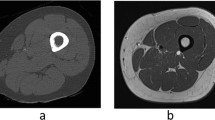Abstract
In this paper, we propose a new fully computerized image analysis method for measuring the thickness of muscles from ultrasound image obtained by muscle endurance test using morphological information of fascia and thoracic vertebra. Firstly, we divide the image into lumbar region and thoracolumbar region by the difference of density in image for measuring the thickness of muscles. In lumbar region, we notice that the intensity of fascia is relatively higher than other parts. Thus, we measure the thickness of muscles surrounding the fascia area. In the process, we apply median filter to candidate fascia areas for extracting candidate muscle layers between fascias. Then, the thickness of muscles we measure is that of the third layer. In thoracolumbar region, we apply region expansion method for classifying the region into subcutaneous fat part and part including thoracic vertebra. Then, we apply counting method and evolutionary computation search model to find the measuring location that is in between subcutaneous fat area and thoracic vertebra. In experiment, the proposed method is effective in measuring the thickness of muscles and avoids failures of previous studies. The performance of this approach is sufficiently comparable to that of medical experts.

















Similar content being viewed by others
References
Conley MS, Stone MH, Nimmons M, Dudley GA (1997) Specificity of resistance training responses in neck muscle size and strength. Eur J Appl Physiol Occup Physio l75(5):443–448
Costa LOP, Maher CG, Latimer J, Smeets RJ (2009) Reproducibility of rehabilitative ultrasound imaging for the measurement of abdominal muscle activity: a systematic review. Phys Ther 89(8):756–769
De Jong KA (2006) Evolutionary computation: a unified approach, vol 262041944. MIT Press, Cambridge
Hebert JJ, Koppenhaver SL, Parent EC, Fritz JM (2009) A systematic review of the reliability of rehabilitative ultrasound imaging for the quantitative assessment of the abdominal and lumbar trunk muscles. Spine 34(23):E848–E856
Katz JN (2006) Lumbar disc disorders and low-back pain: socioeconomic factors and consequences. J Bone Joint Surg 88:21–24
Kim KB, Lee HJ, Song DH, Woo YW (2010) Extracting Fascia and Analysis of Muscles from Ultrasound Images with FCM-based Quantization Technology. Neural Netw World 20(3):405–416
Koppenhaver SL, Hebert JJ, Fritz JM, Parent EC, Teyhen DS, Magel JS (2009) Reliability of rehabilitative ultrasound imaging of the transversus abdominis and lumbar multifidus muscles. Arch Phys Med Rehabil 90(1):87–94
Kremkau FW (2002) Diagnostic ultrasound: principles and instruments WB Saunders. Phila PA:428
Lawrence RC, Helmick CG, Arnett FC, Deyo RA, Felson DT, Giannini EH, Wolfe F (1998) Estimates of the prevalence of arthritis and selected musculoskeletal disorders in the United States. Arthritis Rheum 41(5):778–799
Leigh JP, Markowitz SB, Fahs M, Shin C, Landrigan PJ (1997) Occupational injury and illness in the United States: estimates of costs, morbidity, and mortality. Arch Intern Med 157(14):1557–1568
Rezasoltani A, Ylinen J, Vihko V (2002) Isometric cervical extension force and dimensions of semispinalis capitis muscle. J Rehabil Res Dev 39(3):423–428
Stokes M, Rankin G, Newham DJ (2005) Ultrasound imaging of lumbar multifidus muscle: normal reference ranges for measurements and practical guidance on the technique. Man ther 10(2):116–126
Whittaker JL, Stokes M (2011) Ultrasound imaging and muscle function. J Orthop Sports Phys Ther 41:572–580
Whittaker JL, Teyhen DS, Elliott JM, Cook K, Langevin HM, Dahl HH, Stokes M (2007) Rehabilitative ultrasound imaging: understanding the technology and its applications. J Orthop Sports Phys Ther 37(8):434–449
Acknowledgments
This study was supported by a grant from the National R&D Program for Cancer Control, Ministry for Health, Welfare and Family affairs, Republic of Korea (0920050).
Author information
Authors and Affiliations
Corresponding author
Rights and permissions
About this article
Cite this article
Kim, K.B., Park, H.J. & Kim, G.H. An analysis of muscles from ultrasound image using morphological information of fascia and thoracic vertebra. Multimed Tools Appl 71, 931–945 (2014). https://doi.org/10.1007/s11042-013-1773-5
Published:
Issue Date:
DOI: https://doi.org/10.1007/s11042-013-1773-5




